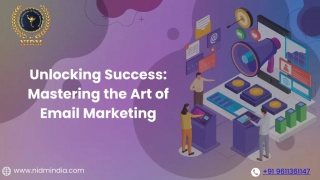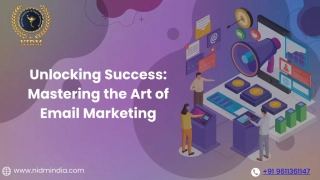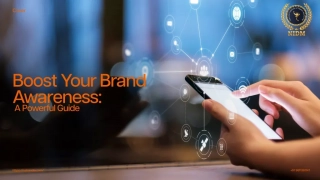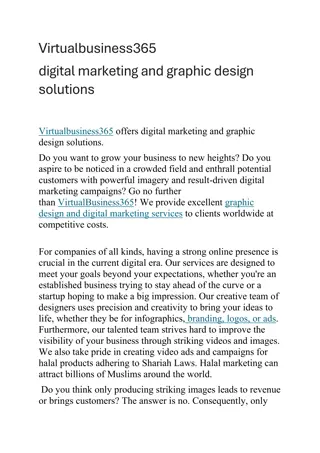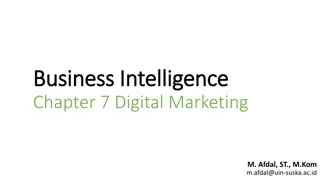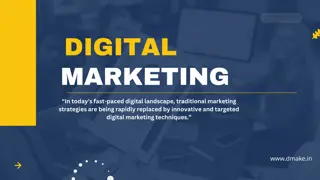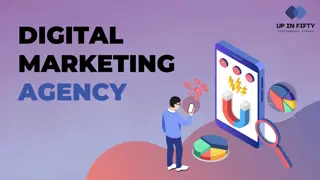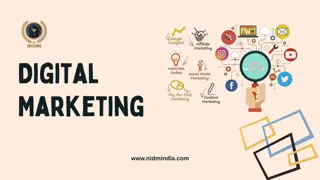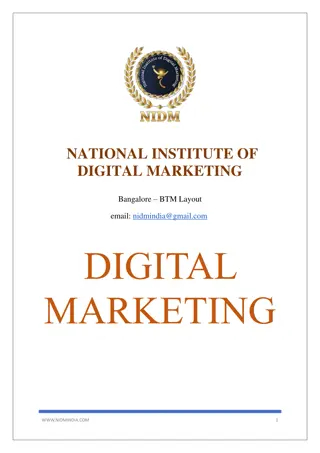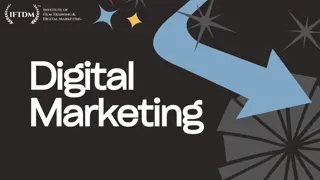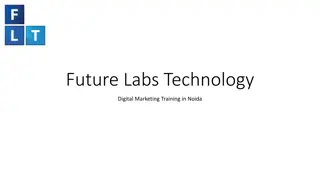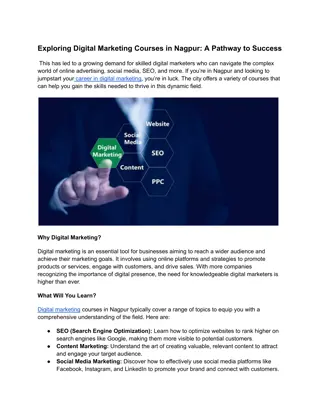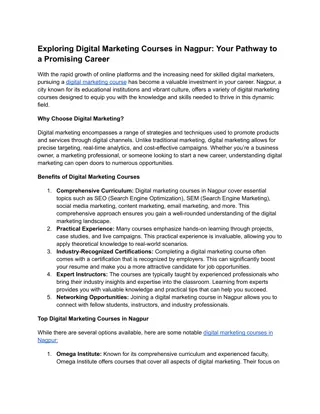The Evolution of Marketing in the Digital Age
Explore the digital revolution's impact on marketing, from the development of the first electronic digital computer to the rise of social media and global crowdfunding. Understand the main tools of digital marketing, the significance of culture, and emerging trends shaping the industry. Delve into key milestones in the digital revolution and the Internet's transformative journey according to AOL's co-founder. Discover the third wave trends in marketing, emphasizing global crowdfunding, purpose-driven partnerships, and regional entrepreneurship globalization.
Download Presentation

Please find below an Image/Link to download the presentation.
The content on the website is provided AS IS for your information and personal use only. It may not be sold, licensed, or shared on other websites without obtaining consent from the author.If you encounter any issues during the download, it is possible that the publisher has removed the file from their server.
You are allowed to download the files provided on this website for personal or commercial use, subject to the condition that they are used lawfully. All files are the property of their respective owners.
The content on the website is provided AS IS for your information and personal use only. It may not be sold, licensed, or shared on other websites without obtaining consent from the author.
E N D
Presentation Transcript
Global Marketing and the Digital Revolution Prof. Jelena Filipovic, Ph.D. Faculty of Economics University of Belgrade 1
Content 1 Explain digital revolution 2 Main tools of digital marketing 3 Importance of culture 4 Trends in digital marketing 2
The Digital Revolution: A Brief History 1937 to 1942: First electronic digital computer was developed 1950s: Invention of the silicon chip (integrated circuit) 1970s: The decade for companies like Atari, Commodore, and Apple 1981: IBM introduced its first personal computer (PC); Bill Gates developed MS- DOS for IBM 1984: Apple introduced the Macintosh 1993: The creation of the Pentium processor 3
The Digital Revolution: Milestones 1969: The Internet can trace its origins (Defense Advanced Research Projects Agency) 1972: E-mail was sent for the first time 1973-1974: The creation of a cross-network protocol; 1993: URL, HTML, and HTTP invented Mid-1990s: First browser, Netscape, was created Web users: 1993 - 600,000, 1998 - 40 million; today 5.2 billion Search engines Google and Yahoo! Bing have improved security features 4
The Internet Revolution according to Steve Case, AOL Cofounder First Wave: mid-1980s, companies like Cisco & Xilinx created core technologies (routers) that were the on ramps to the Internet Second Wave: 2000-2014; focus shifted to building on top of the Internet: search engines, encryption & security, social media Third Wave: A future when the Internet is seamlessly integrated into everyday life; already occurring with Lyft & Uber. An era of reinvention & disruption in key economic sectors 5
Cases Third Wave Trends Capital for all: global crowdfunding (GoFundMe & Kickstarter) Reemergence of partnerships where who a company partners with is as important as what it does Social enterprise that links profit & purpose (Tom s Shoes, Warby Parker, Tesla) Rise of the rest: globalization of entrepreneurship becomes regional, not in startup hotbeds like Silicon Valley 6
Industry Convergence The 2000s were the broadband decade, the disintermediation decade, the file-sharing decade, the digital recording (and image) decade, the iPod decade, the long-tail decade, the blog decade, the user-generated decade, the on-demand decade, the all-access decade. Inaugurating the new millennium, the Internet swallowed culture whole and delivered it back- cheaper, faster, and smaller-to everyone who can get online. Jon Pareles, New York Times columnist 7
Industry Convergence Convergence: The coming together of previously separate industries and product categories. 8
Digital Marketing Digital marketing, also called online marketing, is the promotion of brands to connect with potential customers using the internet and other forms of digital communication. This includes not only email, social media, and web-based advertising, but also text and multimedia messages as a marketing channel. 9
Global E-Commerce 11
Divided into three broad categories: Business to Business (B2B) largest share of the Internet economy Business to Consumer (B2C) - iTunes Consumer to Consumer (Peer to peer) - eBay 12
Global E-Commerce E-commerce is the general exchange of goods and services using the Internet or a similar online network as a marketing channel. $5.2 trillion market In 2021, China became the largest market for e-commerce with a revenue of $1.5 trillion, placing it ahead of the USA. Alibaba's Taobao and Tmall, (50.8% market share) followed by JD.com and Pinduoduo are the domestic platforms that dominate China's e-commerce market. Online retail in Western Europe grew at 11.3% rate between 2017-2022 13
The Long Tail Use of efficient economics of online retail to aggregate slow-selling products eBay, Amazon.com., Netflix, i Tunes The Long Tail is really about the economics of abundance what happens when the bottlenecks that stand between supply and demand in our culture start to disappear and everything becomes available to everyone These millions of fringe sales are an efficient, cost-effective business hits and niches are on equal footing. Chris Anderson, Author of Wired 14
Internet as a Communications Tool Products not viable for Internet sales or firms limit sales to support off-line sales Lack of infrastructure Cost of e-commerce site can be $20-$30 million Some product-specific factors may limit online sales 15
Issues that global websites face with: Register a country-specific domain name Cybersquatting Arranging payment-credit card usage rate, fraud, postal money order, or bank check Localizing sites reflect local culture, language, aesthetics Addressing privacy issues - EU laws more stringent Setting up distribution-local sales tax issues 1. 2. 3. 4. 5. 16
GLOBAL MARKET RESEARCH Learn about your audience! Before launching any digital marketing campaign, it is essential to conduct in-depth research on the target market. 17
Task of Global Marketers Study and understand the cultures of countries in which they will be doing business Understand how an unconscious reference to their own cultural values, or self-reference criterion, may influence their perception of the market Incorporate this understanding into the marketing planning process 18
Research Methodologies Digital surveys Focus groups Social media analytics 19
Society, Culture, and Global Consumer Culture Global consumer cultures are emerging Persons who share meaningful sets of consumption-related symbols Pub culture, coffee culture, fast-food culture, credit card culture, soccer culture Primarily the product of a technologically interconnected world: Internet & Satellite TV Can be exploited by Global Consumer Culture Positioning 20
Global consumer culture positioning Identifies the brand as a symbol of a particular global culture or segment High-touch and high-tech products 21
Aesthetics The sense of what is beautiful and what is not beautiful What represents good taste as opposed to tastelessness or even obscenity Visual-embodied in the color or shape of a logo, website or images shared on social media Styles-various degrees of complexity, for example, are perceived differently around the world 22
Aesthetics and Color Red-associated with blood, wine-making, activity, heat, and vibrancy in many countries but is poorly received in some African countries. Blue-since the pigment was rare, ancient Egyptians, Chinese, Mayans associated it with royalty and divinity. White-identified with purity and cleanliness in the West, with death in parts of Asia. Gray-means inexpensive in Japan and China, but high quality and expensive in the U.S. 23
Music Found in all cultures Rhythm is universal Styles are associated with countries or regions: bossa nova & Argentina, salsa & Cuba, reggae & Jamaica, blues, rap, rock, & country Understand what style is appropriate in videos; varies by culture and government regulations 24
Language and Communication Semiotics-the study of signs and their meanings Semiotics includes both spoken and unspoken language Unspoken language includes gestures, touching, body language Spoken language has four areas 25
26 Verbal Language Linguistic Category Language Example Syntax-rules of sentence formation English has relatively fixed word order; Russian has relatively free word order. Semantics-system of meaning Japanese words convey nuances of feeling for which other languages lack exact correlations; yes and no can be interpreted differently than in other languages. Phonology-system of sound patterns Japanese does not distinguish between the sounds l and r ; English and Russian both have l and r sounds. Morphology-word formation Russian is a highly inflected language, with six different case endings for nouns and adjectives; English has fewer inflections.
Limitations and Challenges There are challenges of working with different languages and cultures 27
28 Language and Communication When Coca-Cola first entered the Chinese market, the brand name was initially phonetically translated into something that sounded like "Kekoukela", which unfortunately meant "Bite the Wax Tadpole" or "Female Horse Stuffed with Wax", depending on the dialect. The company later changed the phonetic translation to "Kekoukele", meaning "Happiness in the Mouth", which resonated much better with the Chinese consumers. vs.
29 Pronunciation Problems Colgate in Spanish means go hang yourself IKEA hired linguists to rename products in Thailand because they had sexual connotations Whirlpool spent large sums on advertising only to find out that French, Italian, & German consumers could not pronounce the brand name Diesel brand name was chosen because it is pronounced the same in all languages
30 Cell Phones & Texting Thumbs Up Emoji In Korea, certain number combinations have special meanings 8282 (Paul Yi Pal Yi) sounds like hurry up 7179 (Chil Han Chil Han) = close friend 4 5683 968 = I Love You Clapping Hands Emoji Folded Hands Emoji Peace Sign Emoji Smiling Emoji with Open Mouth and Cold Sweat
31 Language & Communication English Around the Globe Nonverbal Communication More people speak English as a 2nd language than there are native speakers 85% of EU teens study English Sony requires upper managers to pass a proficiency test In the Middle East, Westerners should not pass documents with the left hand In Japan, bowing has many nuances Asians place greater value on nonverbal communication than Westerners
32 High- and Low-Context Cultures High Context Information resides in context Emphasis on background, basic values, societal status Less emphasis on legal paperwork Focus on personal reputation Low Context Messages are explicit and specific Words carry all information Reliance on legal paperwork Focus on non-personal documentation of credibility Switzerland, U.S., Germany Saudi Arabia, Japan
33 High- and Low-Context Cultures Digital High-Context Cultures Low-Context Cultures Marketing Area Use of rich visuals, subtle cues, and layered information. Importance of aesthetic appeal and cultural symbols. Clarity, simplicity, and explicit information are important. Direct, text-based communication is favored. Web-Site Design More likely to be formal, indirect, and nuanced, relying on politeness and relationship building. More focus on visuals and design elements. Tend to be direct, clear, and to-the-point. More emphasis on clear text-based content and direct calls to action. Email Design More focus on long-tail keywords and context-based search queries. Local dialects and idioms might play important role. More focus on exact-match keywords and direct search queries. SEO Emphasis on individual interactions, information sharing, and direct communication. Clear, text-based content is preferred. More focus on reaching a broad audience with clear, direct messaging. Facts, credentials, and achievements are key. Emphasis on community building, relationship nurturing, and group interactions. Visuals, symbols, and implicit cues are important. Social Media More focus on relationship building with key influencers and community leaders. Reputation, shared values, and trust are paramount. Online PR
Trends in Global Digital Marketing Latest trends in mobile gaming, streaming video, digital books, and wearables, which are shaping the way we consume media and interact with technology today. 34
Broadband Technology Has sufficient capacity to carry multiple voice, data, or video channels simultaneously. Bandwidth determines the range of frequencies that can pass over a transmission channel. South Korea has the world's fastest Internet speeds. 35
Cloud Computing Cloud Software will not be installed on a computer hard drive but through a web browser. Google's Chrome OS is designed for the cloud. Amazon Web Service provides cloud- computing resources for business. Growth rate of 25% over the next several years. 36
Mobile Technologies 1.5 billion smartphones shipped in 2017. Conventional cell phones allow texting via short message service (SMS). Mobile advertising and commerce conducted via Wi-Fi or cellular data plans. 5G networks enable a new kind of network that is designed to connect virtually everyone and everything together. 37
Mobile Advertising and Commerce Terms for delivering advertising messages and conducting product and service transactions using cell phones. GPS on phones led to location-based advertising. 47 of the world's 70 largest economies now have active 5G networks. 38
Mobile Commerce and Autonomous Mobility Bluetooth-uses less power than Wi-Fi, works well with cell phones, and covers shorter distances than Wi-Fi. The Internet of Things is coming into being as refrigerators, lighting systems, and microwave ovens are connected to the Internet. As Internet-connected cars become reality, automakers are creating apps that enable drivers to check on their cars. With self-driving and electric cars coming to market soon, most automakers have research facilities in Silicon Valley. 39
Mobile Music Mobile music streaming services like Spotify and Pandora have matured the market for paid downloads. Mobile gaming revenues amounted to $152 billion in 2021. Cloud-based music services like i Tunes Match or Google Play offer "music lockers" for access from multiple devices. 40
Mobile Gaming & Payments Mobile gaming revenue has grown from $3.77 billion in 2010 to over $150 billion in 2022. Asia-Pacific has more than half of the world market, with China's 600 million players spending over $25 billion a year. E-sports are a popular form of video game competition, with an industry valued at $1600 million revenue. Mobile payments have exploded since the launch of Apple Pay in 2014, enabling users to connect smartphones to their bank accounts. 41
Pokmon Go Phenomenon Pok mon Go is a popular mobile game based on augmented reality. Pok mon Go became the most downloaded app in the U.S., Australia, and New Zealand before launching in Japan. Japan is the world's largest market for mobile games. 42
Streaming Video YouTube has 1.3 billion daily viewers, with 5 billion videos viewed daily. Social media platforms like Facebook, Instagram, and Twitter have also become popular digital video services. Netflix is a leading subscription-based streaming video platform. Global broadband penetration has fueled the growing popularity of streaming video services. 43
Digital Books & Electronic Reading Devices Amazon's Kindle, Barnes & Noble's Nook, and Apple's iPad have transformed the book industry. Textbooks represent a huge market opportunity for publishers. Piracy is a concern for many authors. 44
Wearables Wearables like Google Glass and Apple Watch are reaching a tipping point in fashion and sales. smartwatches, hearables, fitness and health trackers, smart jewelry, and smart clothing 6 million wearable units were sold in 2013, rising to 113 million in 2018, and even to 492 million in 2022. 45
Outlook for Digital Media Digital media is expected to continue growing rapidly, driven by technological innovation and changing consumer preferences. Emerging technologies like virtual and augmented reality and artificial intelligence promise to further transform the media and entertainment landscape. 46





